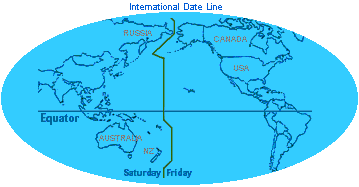
The International Date Line is the imaginary line on the Earth that separates two consecutive calendar days. That is the date in the Eastern hemisphere, to the left of the line, is always one day ahead of the date in the Western hemisphere. It has been recognized as a matter of convenience and has no force in international law.
The date line on the earth's surface, generally following the 180° meridian of longitude, where, by international agreement, travelers change dates. Traveling eastward across the line, one subtracts one calendar day; traveling westward, one adds a day. The date line is necessary to avoid a confusion that would otherwise result. For example, if an airplane were to travel westward with the sun, 24 hr would elapse as it circled the globe, but it would still be the same day for those in the airplane while it would be one day later for those on the ground below them. The same problem would arise if two travelers journeyed in opposite directions to a point on the opposite side of the earth, 180° of longitude distant. The eastward traveler would set his clock ahead 1 hr for each 15° of longitude (see standard time), so that his clock would gain a total of 12 hr; the westward traveler would set his clock back 1 hr for each 15°, resulting in a total loss of 12 hr. The two clocks would therefore differ by 24 hr, or one calendar day. The apparent paradox is resolved by requiring that the traveler crossing the date line change his date, thus bringing the travelers into agreement when they meet. The international date line does not follow the 180° meridian along its entire course but bends eastward around the eastern tip of Siberia, westward around the Aleutian Islands, and eastward again around various island groups in the South Pacific in order to avoid a time change in populated areas.
Without the International Date Line travelers going westward would discover that when they returned home, one day more than they thought had passed, even though they had kept careful tally of the days. This first happened to Magellan's crew after the first circumnavigation of the globe. Likewise, a person traveling eastward would find that one fewer days had elapsed than he had recorded, as happened to Phileas Fogg in "Around the World in Eighty Days" by Jules Verne.
The International Date Line can be anywhere on the globe. But it is most convenient to be 180° away from the defining meridian that goes through Greenwich, England. It also is fortunate that this area is covered, mainly, by empty ocean. However, there have always been zigs and zags in it to allow for local circumstances.
Over the years, the position of the International Date Line has changed several times. Until 1845, the Philippines were on the eastern side of it (the same side as the United States). It was on the eastern side of the line because it was a Spanish colony and most Europeans arrived there via the Spanish colonies in South America. Indonesia, almost directly to the South of the Philippines, was a Dutch colony and most European arrivals came via the Cape of Good Hope. Thus Indonesia was to the west of the International Date Line. After the independence of the South American countries, most people traveling to the Philippines also came by way of the Cape of Good Hope, so it was decided to change from the east of the line to the west of the line. Alaska, originally claimed by Russia, was to the west of the International Date Line because most travelers arrived there by way of Siberia. When the United States bought Alaska in 1867 the line was moved to the west of it. The most recent change in the line was in 1995 when Kiribati moved a large segment of it to the east, so that the entire nation would be on the same side of the International Date Line. As with all other changes in the International Date Line, the change was made by a government with local interests. As a result, the line is as far East as 150°, farther east than Honolulu. This does not change where the first sunrise of the next millennium will occur, however. The honor still goes to Antarctica
The position given on most maps is the line drawn by the British Admiralty in 1921.
Now have all your Singles Tour questions answered by one of our Tour Representatives 7 days a week, from 9AM to 9PM MST, by calling our Tour Info line at (602) 553-8178
|
Announcing Our Live Telephone Forum
Be a part of
Perm Women
's only live telephone discussion group as our panel answers your questions concerning Foreign brides, immigration issues, cultural differences and
Foreign marriage services/Singles Tours. Our panel often includes John Adams, President of
Perm Women
, Bud Patterson, a leading expert, past Singles Tour clients and real foreign ladies who have happily married American men just like you. You will be joined by up to 100 callers from around the world
for an hour or more of informative, current, and important information for anyone considering meeting and marrying a foreign bride. It's free, informative, and fun,
so mark it on your calendar and be sure to call in and join the conversation!
|